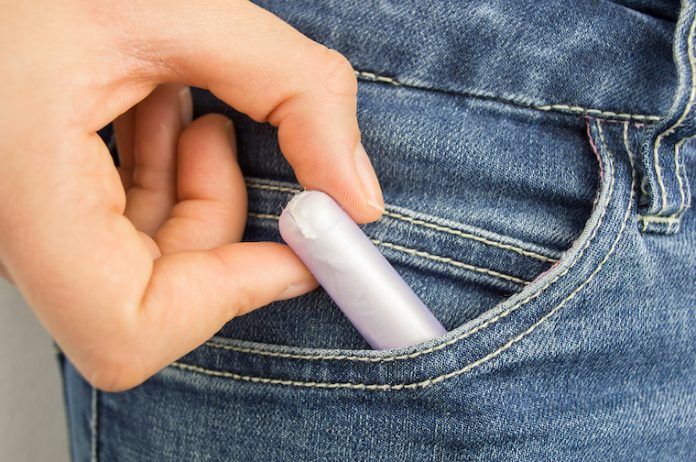
Menstruation is a natural part of a woman’s life cycle, however, a woman’s period can have an unnatural impact on the environment. In fact, as one of Nature’s most life-supporting processes, it can have long-term damaging effects when it comes to the planet.
What can women do to alleviate the negative impact of their period on the environment? Let’s explore these questions.
One planet, billions of periods
From menarche (first period) to the last at menopause, women experience an average of 450 periods over their lifetime. Although the total number varies widely by women, every period has an impact on our environment based on the period products used – whether tampons, pads, or a menstrual cup.
According to an article in the Journal of Clinical Microbiology, women use between 11 and 30 tampons per menstrual cycle, which translates to approximately 5,000 to 14,000 tampons per woman during their lifetime. That’s a lot of opportunities to have a small or large ecological impact.

Impact of period products on the planet
You may be wondering why there is such a huge impact on the environment beyond the sheer numbers of period products used worldwide. One unfortunate fact is that many women are still flushing used tampons down the toilet, despite repeated warnings not to do so. Used tampons should be thrown into the trash. Even biodegradable tampons should be tossed and not flushed, as all tampons can clog toilets as well as septic and sewer systems, which ultimately damages our clean water sources.
The pads and tampons themselves are not the only environmental nightmare. The packaging and liners used with conventional period products are typically not recyclable or they are not being recycled properly, which adds further waste to landfills. In 2015, The Ocean Conservancy gathered 27,938 used tampons and tampon applicators on beaches around the world in one day alone. They represent a tiny tip of the iceberg of the more than 45 billion period products thrown away every year.
What do these conventional period products have in common? Plastics, for one thing. For example, many tampons have plastic applicators while pads and tampons are wrapped in plastic, have a plastic layer to protect clothing, and both linger in the environment for centuries and pollute our oceans and other waterways. Cardboard applicators are more environmentally friendly as they can be recycled or composted properly.
Most conventional tampons and pads themselves also contain plastic. The typical conventional tampon is composed of nonorganic cotton and rayon to increase absorbency. They may also have a thin layer of plastic-encased inside it and you would never know it was there. The tampon is then enveloped in a plastic tube (or cardboard) and wrapped in plastic. Conventional menstrual pads often have a plastic base and synthetics that absorb fluid and are then wrapped in plastic as well. Nothing in this scenario is recyclable.

In fact, according to City to Sea, one conventional menstrual pad has the environmental impact of four plastic grocery bags because of the polyethylene, polypropylene, and/or polyester in them. These plastics take centuries to break down!
Then there are the dioxins to consider. The cotton and rayon in tampons are bleached to make them look white. The chlorine-free bleaching technique used today involves chlorine dioxide and produces dioxins, although at lower levels than previous methods. Dioxins have been linked with a greater risk of cancer.
When we consider all of these facts, it’s clear women need to try something different to help curb the growing problem of period product pollution.
How to reduce your period product pollution
Fortunately, women have cleaner, safer, more environmentally friendly choices than conventional tampons and sanitary pads. 100 percent organic cotton brands such as Natracare help reduce period product pollution because their products are biodegradable. By using 100 percent organic cotton period products, you also help reduce the number of pesticides introduced to the environment and the plants and animals.
When choosing 100 percent cotton menstrual products, also be sure to choose one without an applicator or if you prefer an applicator choose cardboard over plastic. Look for packaging that is either minimal or recyclable (and be sure to recycle it!) (For example, Natracare tampons without an applicator are wrapped in recyclable plastic to ensure the products stay clean. Until a natural biodegradable solution is found, this will still keep your plastic pollution to a minimum). And please remember, never flush your tampons down the toilet!
Another planet-friendly choice is a menstrual cup, which is a silicone catchment system that is reusable. These cups can last three years or longer and therefore significantly reduce pollution.
Bottom line
Menstruation is a natural process, but our use of period products for our periods has an unnatural impact on the environment. You can significantly reduce that impact by choosing 100 percent organic cotton tampons and pads and not flushing tampons down the toilet.
For more information on period products read more here:
Celebrating the Organic Cotton Tampon
A Tampon Experiment: A Picture Tells the Tale
Avoid Plastics and Toxins in Feminine Hygiene Products
Sources
Borunda A. The story of plastic: how tampons and pads became so unsustainable. National Geographic 2019 Sep 6
Change to Green. Facts
Chase DJ. A prospective, randomized, double-blind study of vaginal microflora and epithelium in women using a tampon with an aperture film cover compared with those in women using a commercial tampon with a cover of nonwoven fleece. Journal of Clinical Microbiology 2007 Apr; 45(4): 1219-24
Thorpe JR. Tampon disposal and other period habits impact the environment in some scary ways. Bustle 2018 Apr 25




